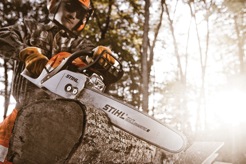Chainsaws are Outdoor Work Timesavers — But Safety Must Come First
Chainsaws are indispensible tools for many outdoor work tasks. They are great for felling, limbing, bucking, pruning, harvesting firewood, culling invasive plant species, putting in trails and firebreaks, wildland fire suppression, severe weather storm damage cleanups, cutting concrete, and, for the artsy, ice and wood carving. It’s hard to imagine how our forefathers managed to do all these things with axes and handsaws.
Two Scottish physicians invented the chainsaw concept in 1784. They devised a rotating saw blade, powered by a hand-turned wheeled assembly, to perform bone-cutting surgical amputations and autopsies. Little else progressed toward the development of the modern chainsaw until the 1920’s. Joseph Cox, from Oregon, invented the modern saw chain linkage system, with specially designed beveled teeth for wood cutting, early in the decade; and, German inventor Andreas Stihl patented an electric powered, followed by gasoline powered, chain saw during 1924-1929. These early chain saws were awkward, heavy, and often required two people to operate.
After World War II, improvements in aluminum manufacturing and small engine design and performance led the way to our modern, lightweight, chainsaw. We should always be mindful, however, that the original concept was for cutting bones–an unfortunate factor dominating contemporary accident and safety statistics and highlighting that some folks ought to learn better the ins and outs of chain sawing.
In the last five years, chainsaw accidents have increased 10% annually across the nation, with 135,000 injuries and five deaths, nation-wide, last year. Saw blade cut accidents, eye injuries, and hearing loss account for many of the injuries, but nearly 10% involve head injuries or deaths caused by trees or tree limbs falling on the victims.
Most chainsaw accidents can be avoided by following some simple safety rules:
1. Saw engines and chain systems must be maintained to run properly.
2. You should wear personal protective equipment.
3. If you don’t know how to fell a tree correctly, don’t try.
4. When sawing, keep steady, unobstructed footing, use both hands on the saw, and don’t cut above your shoulder level.
5. There can be no obstructions along the chain’s cutting pathway, like a nail, rock, or woody debris.
6. Avoid improper cutting techniques which cause binding, kickback, pushback, or pull-in.
William Nobbe & Company and Clifftop co-hosted a chainsaw safety workshop on Saturday, July 13th, 2013.
CLIFFTOP, a local nonprofit organization, is focused on preserving and protecting area bluff lands.
A version of this article appeared in the 21 June 2013 edition of the Monroe County Independent.
© 2013 all content rights reserved Clifftop NFP.
Comments are currently closed.

